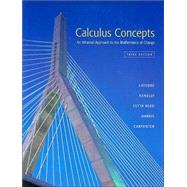
Note: Supplemental materials are not guaranteed with Rental or Used book purchases.
Purchase Benefits
| Note: Each chapter contains a Summary, a Concept Check, and a Review Test | |
| Ingredients of Change: Functions and Linear Models | |
| Models, Functions, and Graphs | |
| Constructed Functions | |
| Functions, Limits, and Continuity | |
| Linear Functions and Models Project | |
| Tuition Fees Project | |
| United States Population | |
| Ingredients of Change: Nonlinear Models | |
| Exponential Functions and Models | |
| Logarithmic Functions and Models | |
| Logistic Functions and Models | |
| Polynomial Functions and Models | |
| Choosing a Function to Fit Data Project | |
| Compulsory School Laws Project | |
| Fund-Raising Campaign | |
| Describing Change: Rates | |
| Change, Percentage Change, and Average Rates of Change | |
| Instantaneous Rates of Change | |
| Derivatives | |
| Numerically Finding Slopes | |
| Algebraically Finding Slopes Project | |
| Fee-Refund Schedules Project | |
| Doubling Time | |
| Determining Change: Derivatives | |
| Drawing Rate-of-Change Graphs | |
| Simple Rate-of-Change Formulas | |
| More Simple Rate-of-Change Formulas | |
| The Chain Rule | |
| The Product Rule Project | |
| Superhighway Project | |
| Fertility Rates | |
| Analyzing Change: Applications of Derivatives | |
| Approximating Change | |
| Relative and Absolute Extreme Points | |
| Inflection Points | |
| Derivatives in Action | |
| Interconnected Change: Related Rates Project | |
| Hunting License Fees Project | |
| Fund-Raising Campaign | |
| Accumulating Change: Limits of Sums and the Definite Integral | |
| Results of Change and Area Approximations | |
| Limit of Sums, Accumulated Change, and the Definite Integral | |
| Accumulation Functions | |
| The Fundamental Theorem | |
| The Definite Integral | |
| Average Value and Average Rate of Change | |
| Antiderivative Limitations Project | |
| Acceleration, Velocity, and Distance Project | |
| Estimating Growth | |
| Analyzing Accumulated Change: Integrals in Action | |
| Perpetual Accumulation and Improper Integrals | |
| Streams in Business and Biology | |
| Integrals in Economics | |
| Probability Distributions and Density Functions Project | |
| Arch Art | |
| Repetitive Change: Cycles and Trigonometry | |
| Functions of Angles: Sine and Cosine | |
| Cyclic Functions as Models | |
| Rates of Change and Derivatives | |
| Extrema and Points of Inflection | |
| Accumulation in Cycles Project | |
| Seasonal Sales Project | |
| Lake Tahoe Levels | |
| Ingredients of Multivariable Change: Models, Graphs, Rates | |
| Multivariable Functions and Contour Graphs | |
| Cross-Sectional Models and Rates of Change | |
| Partial Rates of Change | |
| Compensating for Change Project | |
| Competitive and Complementary Products Project | |
| Expert Witness | |
| Analyzing Multivariable Change: Optimization | |
| Multivariable Critical Points | |
| Multivariable Optimization | |
| Optimization Under Constraints | |
| Least-Squares Optimization Project | |
| Snow Cover Project | |
| Carbonated Beverage Packaging | |
| Answers to Odd Activities | |
| Index of Applications | |
| Subject Index | |
| Chapter 11 and the Appendices are available via the Internet | |
| Dynamics of Change: Differential Equations and Proportionality | |
| Differential Equations and Slope Fields | |
| Separable Differential Equations | |
| Numerically Estimating by Using Differential Equations: Euler's Method | |
| Second-Order Differential Equations Chapter 11 | |
| Answers to Odd Activities | |
| Trigonometry Basics Trigonometry Basics Answers to Appendix A | |
| Strengthening the Concepts | |
| The Pythagorean Theorem Solving | |
| Exponential Equations Algebraically | |
| Graphing Piecewise Functions | |
| Constructing Inverse Functions | |
| Algebraically Determining End Behavior Algebraically | |
| The Limit at a Point Polynomial and Rational Functions | |
| Continuity Defined APR and APY Exponents and Radicals Squaring and Cubing Binomials | |
| The Constant Multiplier and Sum Rules for Derivatives | |
| Negative and Fractional Exponents | |
| Formulas for Geometry-Related Problems | |
| Solving Systems of Equations | |
| Algebraically Answers to Appendix B | |
| Solutions to Appendix B | |
| Appendix C: Strengthening the Skills | |
| Skill Strengthening | |
| Skill Strengthening | |
| Skill Strengthening | |
| Skill Strengthening | |
| Skill Strengthening | |
| Skill Strengthening | |
| Answers to Appendix C | |
| Solutions to Appendix C | |
| Table of Contents provided by Publisher. All Rights Reserved. |
The New copy of this book will include any supplemental materials advertised. Please check the title of the book to determine if it should include any access cards, study guides, lab manuals, CDs, etc.
The Used, Rental and eBook copies of this book are not guaranteed to include any supplemental materials. Typically, only the book itself is included. This is true even if the title states it includes any access cards, study guides, lab manuals, CDs, etc.